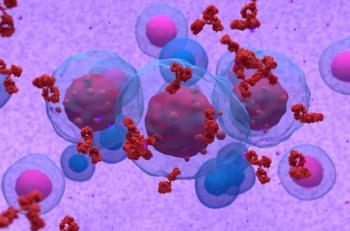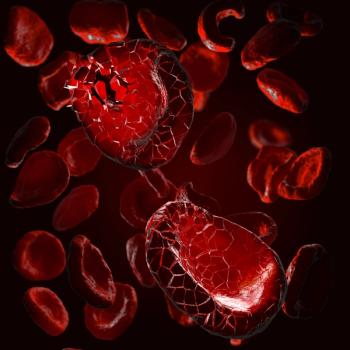
Pomalidomide Combo Yields PFS/OS Benefits in R/R Multiple Myeloma
Pomalidomide plus bortezomib and dexamethasone confers a larger progression-free survival benefit than bortezombib plus dexamethasone among patients with relapsed/refractory multiple myeloma in the phase 3 OPTIMISMM trial.
Treatment with pomalidomide (Pomalyst) plus bortezomib (Velcade) and dexamethasone (PVd) produced a nonsignificant overall survival (OS) benefit and a significant progression-free survival (PFS) benefit compared with bortezomib plus dexamethasone (Vd) in relapsed/refractory multiple myeloma, according to findings from the phase 3 OPTIMISMM trial (NCT01734928) presented at the
At the May 13, 2022 data cutoff, with a median follow-up of 64.5 months, revealed that patients who received Pvd (n = 281) achieved a median OS of 35.6 months compared with 31.6 months among patients treated with Vd (n = 278; HR, 0.94; 95% CI, 0.77-1.15; P = .571). The 36- (49% vs 45%) and 72-month (26% vs 23%) OS rates both slightly favored the PVd arm.
The median PFS in the PVd arm was 11.7 months compared with 6.9 months in the Vd cohort (HR, 0.56; 95% CI, 0.46-0.68; P < .0001). The 36-month PFS rates were 20% vs 7%, respectively, and the 72-month PFS rates were 10% vs 2%, respectively.
OPTIMISMM was an open-label trial that randomly assigned patients with relapsed/refractory multiple myeloma who had undergone 1 to 3 prior treatment regimens to receive either PVd or Vd. Eligible patients also needed to have an ECOG performance status of 2 or loweress and have undergone at least 2 previous cycles of lenalidomide (Revlimid).
“Lenalidomide refractoriness is a very general situation, which is seen when patients are exposed to lenalidomide early in the course of the treatment,” Meral Beksaç, MD, director of the Department of Hematology at Ankara University in Turkey, said during the presentation. “There’s a need for effective therapies in this setting.”
Prior bortezomib was permitted, exceptpect for thospatientse who experienced progressive disease (PD) after treatment with the 1.3 mg/m2 twice-weekly dose. Patients were stratified based on age (≤ 75 years vs > 75 years) prior treatment regimens (1 vs > 1), and β2-microglobulin status at screening (< 3.5 mg/L vs ≥ 3.5 to ≤ 5.5 mg/L vs > 5.5 mg/L).
Patients in the PVd arm received pomalidomide at a dose of 4 mg on days 1 through 14; subcutaneous bortezomib at a dose of 1.3 mg/m2 on days 1, 4, 8, and 11 during cycles 1 through 8 and on days 1 and 8 of cycle 9 and beyond; and dexamethasone at a dose of 20 mg/day (age ≤ 75 years) or 10 mg/day (age > 75 years) on days 1, 2, 4, 5, 8, 9, and 12 of cycles 1 through 8 and days 1, 2, 8, and 9 of cycle 9 and beyond.
Treatment continued until disease progression or unacceptable toxicity. Patients who discontinued treatment because ofdue to progressive diseasePD had a follow-up visit 28 days after discontinuation, and those who ceased treatment prior to disease progression entered into the PFS follow-up period.
The primary end point was PFS. Secondary end points included OS, overall response rate, duration of response, and safety. PFS following a patient’s next line of therapy (PFS2) was also explored.
The baseline patient characteristics were generally well balanced between the 2 arms; the median age in the PVd arm was 67.0 years (range, 29-87) compared with 68.0 years (range, 27-89) in the Vd arm. Most patients in both arms were males (55% vs 53%), did not have high-risk cytogenetics (78% vs 82%), underwent prior stem cell transplantation (57% vs 59%), received prior bortezomib (72% vs 73%), and were refractory to prior lenalidomide (71% vs 69%). The respective median times since diagnosis were 4.0 years (range, 0.2-25.9) vs 4.3 years (range, 0.4-21.8).
Additional findings revealed that PVd also led to a PFS2 benefit in terms of PFS following a patient’s next line of therapy (PFS2) compared with Vd. The median PFS2 was 22.1 months vs 16.9 months with PVd vs Vd,, respectively (HR, 0.77; 95% CI, 0.64-0.94; P = .008). The 36-month PFS2 rates were 34% vs 24%, respectively, and the 72-month PFS2 rates were 17% vs 9%, respectively.
Findings from the OS subgroup analysis showed a trend towards improved OS with PVd vs Vd among a majority of subgroups, but none were deemed to be of statistical significance. The most pronounced benefit with PVd compared with Vd was observed in patients with high-risk cytogenetic abnormalities (HR, 0.68; 95% CI, 0.45-1.03), those with a β2-microglobulin status of at least 3.5 mg/L to a maximum of 5.5 mg/L at screening (HR, 0.745; 95% CI, 0.52-1.06), and males (HR, 0.7885; 95% CI, 0.6054-1.0232).
Most patients in both the PVd (68.3%) and Vd (79.1%) arms received at least 1 subsequent antimyeloma therapy. In a Cox proportional hazards mode that used subsequent therapy as a time-dependent covariate adjusted for stratification factors, a statistically significant improvement in OS was observed in the PVd arm compared with the Vd arm (P = .008).
“In the control arm, after progression, 58.3% of those patients received pomalidomide, whereas in the triplet arm, only 19.2% of patients received pomalidomide [after progression],” Beksaç said. “This difference was taken into account [in our] Cox proportional analysis.”
In the safety population, patients who received PVd (n = 278) had a median treatment duration of 41.2 weeks (range, 1.1-355.4). In the Vd arm (n = 270), the median duration of treatment was 21.4 weeks (range, 0.4-324.4).
Further safety data showed that, in the PVd arm, all patients experienced an any-grade treatment-emergent adverse effect (TEAE). Common any-grade TEAEs included infections and infestations (83%), neutropenia (54%), and fatigue (39%). Grade 3 or 4 TEAEs occurred in 93% of patients and included neutropenia (47%), infections and infestations (35%), and thrombocytopenia (28%). Ten patients experienced a grade 5 TEAE.
In the Vd arm, most patients experienced an any-grade TEAE (98%) and a TEAE of grade 3 or 4 severity (72%). Any-grade TEAEs included infections and infestations (66%), peripheral sensory neuropathy (38%), and fatigue (27%). Grade 3 or 4 TEAEs included thrombocytopenia (29%), infections and infestations (19%), and anemia (14%). Four patients in the Vd arm suffered a grade 5 TEAE.
TEAEs leading to treatment discontinuation occurred in 33% of patients in the PVd arm compared with 20% of patients in the Vd arm. Nervous system disorders (16% vs 12%), general disorders and administration site conditions (4% vs 1%), infections and infestations (4% vs 2%), and respiratory, thoracic, and mediastinal disorders (4% vs < 1%) led to treatment discontinuation in both arms.
Overall, 71% of patients died in the PVd arm compared with 70% of patients in the Vd arm. Ten percent of deaths in the PVd arm occurred during the treatment period vs 4% of deaths in the Vd arm. Most patients in both arms (60% vs 66%) died more than 28 days from the end of treatment.
Disclosures: Beksac reports receiving consultancy fees from Janssen and Menarini; and receiving honoraria from Amgen, Bristol Myers Squibb, Janssen, and Takeda.
Reference
Beksac M, Richardson PR, Oriol A, et al. Pomalidomide, bortezomib, and dexamethasone versuss bortezomib and dexamethasone in relapsed or refractory multiple myeloma (OPTIMISMM): final survival outcomes from a randomized, open-label, phase 3 trial. Presented at: 2023 International Myeloma Society Annual Meeting; September 27-30, 2023; Athens, Greece. Abstract OA-44.
Newsletter
Stay up to date on recent advances in the multidisciplinary approach to cancer.


















































































